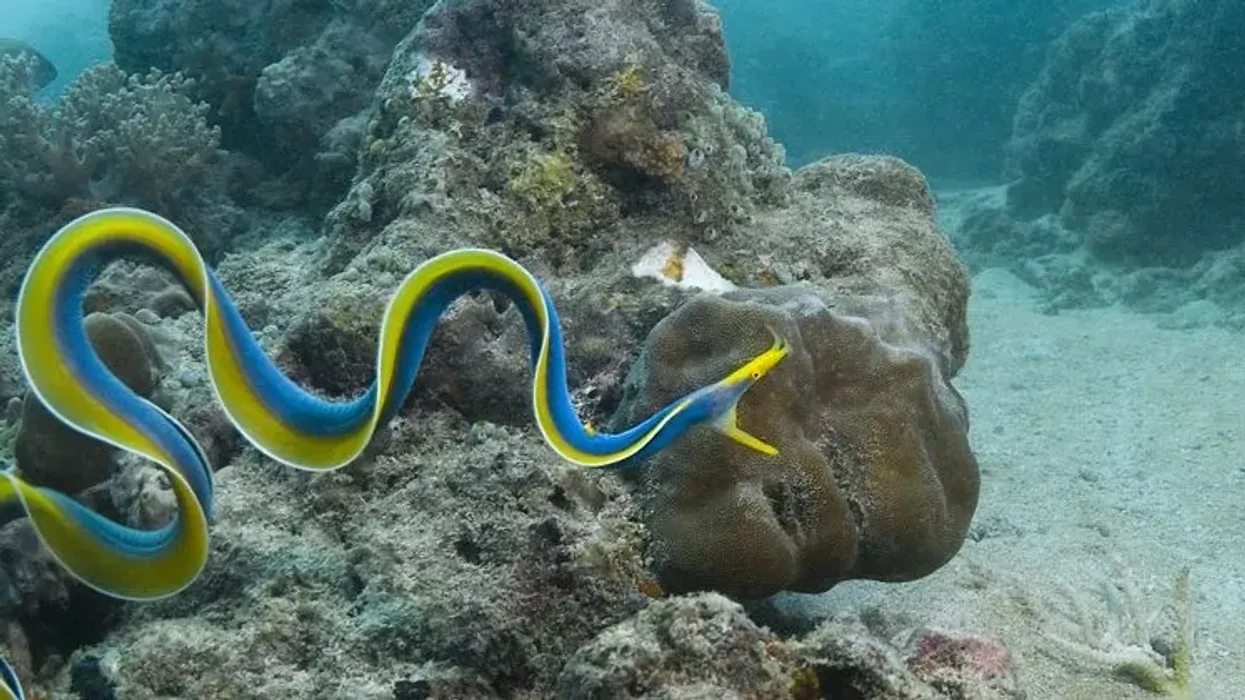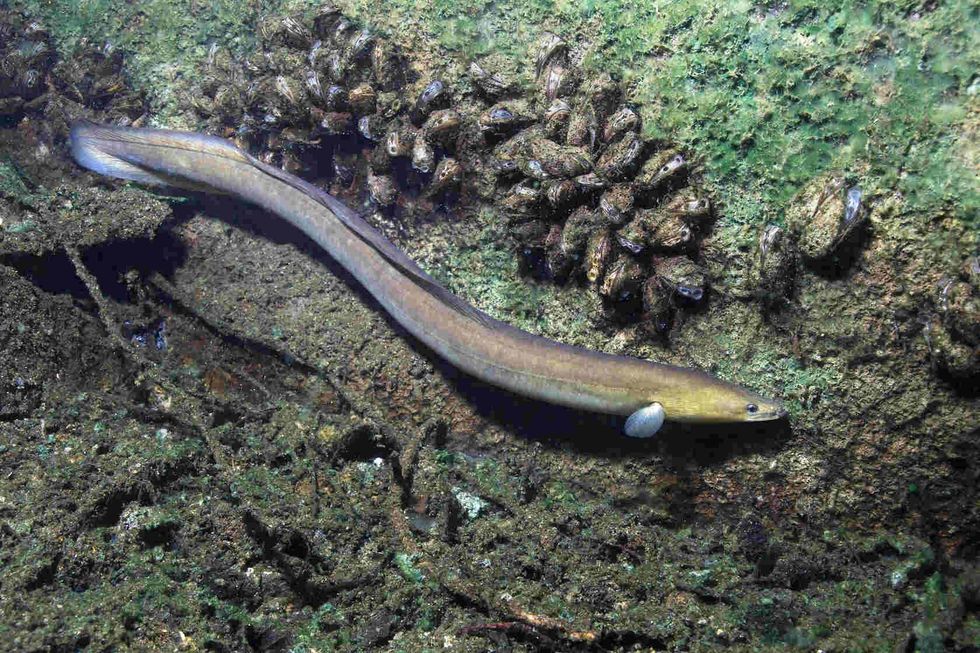Ribbon eels are a species which are also known as the moray eels. They are leaf-nosed and are a species of moray eel.
Ribbon eels are said to be found in the Indo-Pacific ocean, which includes areas like Australia, Japan, East Africa and French Polynesia, among others. Ribbon eels are found in three main colors, including black ribbon eel, blue ribbon eel, transparent ribbon eel, and lemon yellow ribbon eel. However, all of them have a yellow dorsal fin.
Ribbon eels are a type of creature that have similarities when compared to a mythical Chinese dragon. They are long, thin and have dorsal fins that are high.
Ribbon moray eel species can be easily recognized by their anterior nostrils that are expanded. Ribbon eels do not live for a long period of time when they are kept in an aquarium.
After reading about the ribbon moray reel, you may also look at eel facts and moray eel facts.
Ribbon Eel Interesting Facts
What type of animal is a ribbon eel?
Ribbon eels are a type of moray eel. The colorful animals actually belong to the species of moray eels. Ribbons can dive very deep in waters, and are said to be found in reefs or lagoons. Ribbon eels are not rare as their population keeps increasing accordingly.
What class of animal does a ribbon eel belong to?
Ribbon eels belong to the class of Actinopterygii. The color of the subadults and the juveniles are jet black and have a dorsal fin that is yellow in color. For the adult males, the color changes to blue and the color of the adult females is yellow. There are also ghost ribbon eels, also known as white ribbon eels.
How many ribbon eels are there in the world?
There is no specific data as to how many ribbon eels there are in the world. There are different species of eels that vary accordingly and therefore, the number of ribbon eels changes according to different factors which determine their lifespan.
Where does a ribbon eel live?
Ribbon eels usually prefer to live in lagoons and reefs in the Indo-Pacific ocean. They prefer to stay in lagoons that are warm and reefs that are near the coastal areas.
What is a ribbon eel's habitat?
Ribbon eel habitats consist of warm lagoons and coastal reefs near the Indian and Pacific Oceans. They are also found near the offshore islands of Western Australia and the Great Barrier Reef.
Who do ribbon eels live with?
Male ribbon eels are not territorial in nature and therefore stay with two males for a long period of time. They do not change their place and live their life for many years in the same place. The juveniles live on their own.
How long does a ribbon eel live?
The lifespan of a ribbon eel is about 20 years in the wild. They live a long life when they are kept in the wild, and their lifespan reduces when they are kept in captivity. They survive only for a short period of time when they are kept in captivity.
How do they reproduce?
The method in which ribbon eels reproduce is known to be very peculiar. The male and female ribbon eels come across each other only once. After they mate, the female lays leaf-like eggs and dies within a month. The eggs float for around eight weeks in the water before hatching and turning into ribbon eel larvae.
What is their conservation status?
The conservation status of ribbon eels is known to be of the Least Concern. The number of ribbon eels keeps changing based on different factors, such as their surroundings, diet, changes in the climate, and many other factors.
Ribbon Eel Fun Facts
What do ribbon eels look like?
Ribbon eels are also known as blue ribbon eels and they are a species of moray eels. Ribbon eels start off as male and are black in color with a dorsal fin that is yellow in color.
They have a long slender body with high dorsal fins. They differ in color accordingly, as some of them are jet black, electric blue or lemon yellow in color. In fact, ribbon eels might appear as identical to one another as they often share the same features and coloring.
How cute are they?
Ribbon eels are very cute in their appearance as they are different in color and look very adorable, especially with their mouth being yellow in color. They are known to be cute as they come in different colors.
How do they communicate?
Ribbon eel communication is mostly through touch and chemical stimulation. The chemical is released by them in the water which is further detected by the same species and then they read it by creating a reaction. Ribbon eel noises are said to be a high-pitch click that last for a few seconds.
How big is a ribbon eel?
The males range from 25-36 in (63-91 cm) in size, and the females can reach up to 52 in (132 cm). They are medium in size when compared to the other species of ribbon eels.
How fast can a ribbon eel swim?
It is not common to see a ribbon eel swimming in open waters, but when it does, the swimming speed is usually similar to that of other eel species. They swim at around 2.5 mph (4 kmph).
How much does a ribbon eel weigh?
There is no accurate weight of a ribbon eel that is mentioned. The weight of ribbon eels is based on different factors which includes the diet and the nutrition that is required by their body as well as their body size.
It is expected that their weight is in the same range as other eel species at between 1-55 lb (0.4-24 kg).
What are the male and female names of the species?
There is no specific name for the male and female species of ribbon eels.
What would you call a baby ribbon eel?
There is no specific name for a baby ribbon eel.
What do they eat?
Ribbon eel diet consists of shrimp and small fish. They do not prey on big fishes and eat only small fish species that are easy to catch.
Are they rare?
No, ribbon eels are not much rare as their conservation status is of the Least Concern.
Would they make a good pet?
Yes, ribbon eels do make good pets, but it is difficult to have ribbon eel as a pet as blue ribbon eel care is not easy, and it is to be kept only by advanced aquarists. You cannot have ribbon eels as a pet in your house unless you have adequate knowledge of blue ribbon eel feeding requirements.
Did you know...
Some ribbon eels are captured to be kept in aquariums where they live for a short period of time. Once the male’s body reaches a certain length, then it starts to turn yellow and will develop female parts until it is able to lay eggs. Ribbon eels are known to bury themselves in the crevices of the reef.
Their life cycle not only consists of different stages of coloration but they can also change their sex. Ribbon eels use their nostrils to sense the different types of vibrations in the water in order to help them hunt and defend themselves.
Blue ribbon eels stay hidden amongst rock and rubble, waving their heads and anterior bodies in wait for the prey who frequent the lagoons. Their slender bodies allow them to fit in seemingly impossible places.
Blue ribbon eel price range starts from 188 USD and can go up to 388 USD.
Do ribbon eels bite?
Yes, ribbon eels bite when they are threatened. If the ribbon eel bites, then there are chances that you will bleed heavily. Therefore, it is suggested that you should never threaten a ribbon eel as it might bite you.
How to care for a ribbon eel
In order to care for a ribbon eel, you should make sure that the water quality is perfect. Ribbons require a lot of water as they are long. Even if you care for a ribbon eel, there are chances that they might attack you when they are disturbed.
Here at Kidadl, we have carefully created lots of interesting family-friendly animal facts for everyone to discover! Learn more about some other fish including codfish, or fluke fish.
You can even occupy yourself at home by drawing one of our ribbon eel coloring pages.










